engine CITROEN DS4 2018 Repair Manual
[x] Cancel search | Manufacturer: CITROEN, Model Year: 2018, Model line: DS4, Model: CITROEN DS4 2018Pages: 296, PDF Size: 9.91 MB
Page 148 of 296
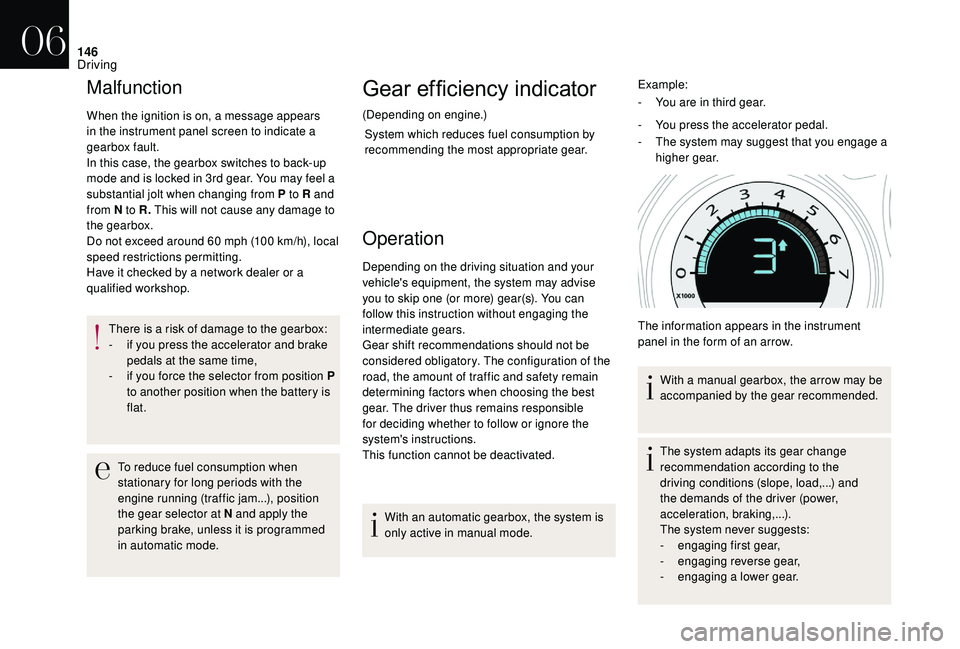
146
Malfunction
When the ignition is on, a message appears
in the instrument panel screen to indicate a
gearbox fault.
In this case, the gearbox switches to back-up
mode and is locked in 3rd gear. You may feel a
substantial jolt when changing from P to R and
from N to R. This will not cause any damage to
the gearbox.
Do not exceed around 60 mph (100 km/h), local
speed restrictions permitting.
Have it checked by a network dealer or a
qualified workshop.There is a risk of damage to the gearbox:
-
i
f you press the accelerator and brake
pedals at the same time,
-
i
f you force the selector from position P
to another position when the battery is
flat.
To reduce fuel consumption when
stationary for long periods with the
engine running (traffic jam...), position
the gear selector at N and apply the
parking brake, unless it is programmed
in automatic mode.
Gear efficiency indicator
(Depending on engine.) System which reduces fuel consumption by
recommending the most appropriate gear.
Operation
Depending on the driving situation and your
vehicle's equipment, the system may advise
you to skip one (or more) gear(s). You can
follow this instruction without engaging the
intermediate gears.
Gear shift recommendations should not be
considered obligatory. The configuration of the
road, the amount of traffic and safety remain
determining factors when choosing the best
gear. The driver thus remains responsible
for deciding whether to follow or ignore the
system's instructions.
This function cannot be deactivated.
With an automatic gearbox, the system is
only active in manual mode. The system adapts its gear change
recommendation according to the
driving conditions (slope, load,...) and
the demands of the driver (power,
acceleration, braking,...).
The system never suggests:
-
e
ngaging first gear,
-
enga
ging reverse gear,
-
enga
ging a lower gear.
Example:
-
Y
ou are in third gear.
-
Y
ou press the accelerator pedal.
-
T
he system may suggest that you engage a
higher gear.
The information appears in the instrument
panel in the form of an arrow. With a manual gearbox, the arrow may be
accompanied by the gear recommended.
06
Driving
Page 149 of 296
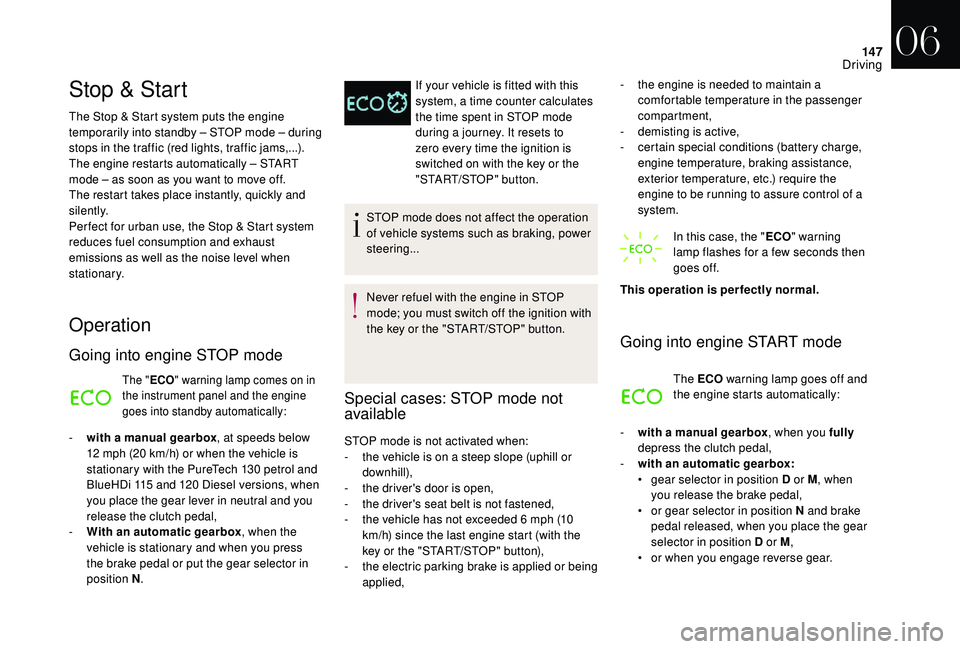
147
Stop & Start
The Stop & Start system puts the engine
t emporarily into standby – STOP mode – during
stops in the traffic (red lights, traffic jams,...).
The engine restarts automatically – START
mode – as soon as you want to move off.
The restart takes place instantly, quickly and
silently.
Per fect for urban use, the Stop & Start system
reduces fuel consumption and exhaust
emissions as well as the noise level when
stationary.
Operation
Going into engine STOP mode
The " ECO" warning lamp comes on in
the instrument panel and the engine
goes into standby automatically:
- with a manual gearbox , at speeds below
12 mph (20 km/h) or when the vehicle is
stationary with the PureTech 130 petrol and
BlueHDi 115 and 120 Diesel versions, when
you place the gear lever in neutral and you
release the clutch pedal,
-
W
ith an automatic gearbox , when the
vehicle is stationary and when you press
the brake pedal or put the gear selector in
position N . If your vehicle is fitted with this
system, a time counter calculates
the time spent in STOP mode
during a journey. It resets to
zero every time the ignition is
switched on with the key or the
"START/STOP" button.
STOP mode does not affect the operation
of vehicle systems such as braking, power
steering...
Never refuel with the engine in STOP
mode; you must switch off the ignition with
the key or the "START/STOP" button.
Special cases: STOP mode not
available
STOP mode is not activated when:
- t he vehicle is on a steep slope (uphill or
downhill),
-
t
he driver's door is open,
-
t
he driver's seat belt is not fastened,
-
t
he vehicle has not exceeded 6 mph (10
km/h) since the last engine start (with the
key or the "START/STOP" button),
-
t
he electric parking brake is applied or being
applied, -
t
he engine is needed to maintain a
comfortable temperature in the passenger
compartment,
-
d
emisting is active,
-
c
ertain special conditions (battery charge,
engine temperature, braking assistance,
exterior temperature, etc.) require the
engine to be running to assure control of a
system.
In this case, the " ECO" warning
lamp flashes for a few seconds then
goes off.
This operation is perfectly normal.
Going into engine START mode
The ECO warning lamp goes off and
the engine starts automatically:
-
w
ith a manual gearbox , when you fully
depress the clutch pedal,
-
w
ith an automatic gearbox:
•
g
ear selector in position D or M , when
you release the brake pedal,
•
o
r gear selector in position N and brake
pedal released, when you place the gear
selector in position D or M ,
•
o
r when you engage reverse gear.
06
Driving
Page 150 of 296
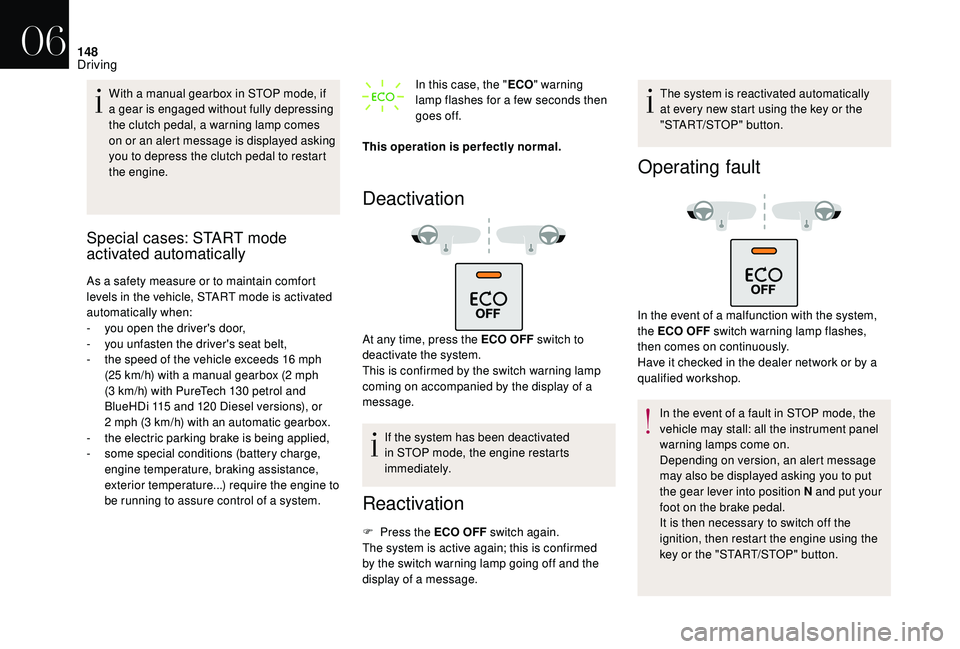
148
With a manual gearbox in STOP mode, if
a gear is engaged without fully depressing
the clutch pedal, a warning lamp comes
on or an alert message is displayed asking
you to depress the clutch pedal to restart
the engine.
Special cases: START mode
activated automatically
As a safety measure or to maintain comfort
levels in the vehicle, START mode is activated
automatically when:
-
y
ou open the driver's door,
-
y
ou unfasten the driver's seat belt,
-
t
he speed of the vehicle exceeds 16 mph
(25 km/h) with a manual gearbox (2 mph
(3
km/h) with PureTech 130 petrol and
BlueHDi 115 and 120 Diesel versions), or
2
mph (3 km/h) with an automatic gearbox.
-
t
he electric parking brake is being applied,
-
s
ome special conditions (battery charge,
engine temperature, braking assistance,
exterior temperature...) require the engine to
be running to assure control of a system. In this case, the "
ECO" warning
lamp flashes for a few seconds then
goes off.
This operation is perfectly normal.
Deactivation
At any time, press the ECO OFF switch to
d eactivate the system.
This is confirmed by the switch warning lamp
coming on accompanied by the display of a
message.
If the system has been deactivated
in STOP mode, the engine restarts
immediately.
Reactivation
F Press the ECO OFF switch again.
The system is active again; this is confirmed
by the switch warning lamp going off and the
display of a message. The system is reactivated automatically
at every new start using the key or the
"START/STOP" button.
Operating fault
In the event of a malfunction with the system,
the ECO OFF switch warning lamp flashes,
then comes on continuously.
Have it checked in the dealer network or by a
qualified workshop.
In the event of a fault in STOP mode, the
vehicle may stall: all the instrument panel
warning lamps come on.
Depending on version, an alert message
may also be displayed asking you to put
the gear lever into position N and put your
foot on the brake pedal.
It is then necessary to switch off the
ignition, then restart the engine using the
key or the "START/STOP" button.
06
Driving
Page 151 of 296
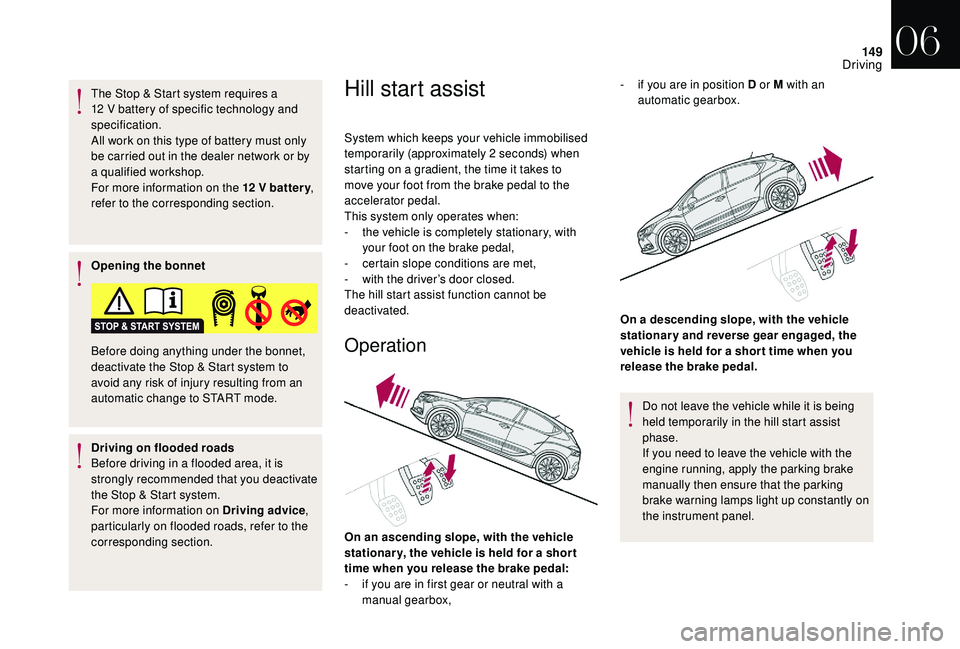
149
The Stop & Start system requires a
12 V battery of specific technology and
specification.
All work on this type of battery must only
be carried out in the dealer network or by
a qualified workshop.
For more information on the 12 V batter y ,
refer to the corresponding section.
Opening the bonnet
Driving on flooded roads
Before driving in a flooded area, it is
strongly recommended that you deactivate
the Stop & Start system.
For more information on Driving advice ,
particularly on flooded roads, refer to the
corresponding section. Before doing anything under the bonnet,
deactivate the Stop & Start system to
avoid any risk of injury resulting from an
automatic change to START mode.Hill start assist
System which keeps your vehicle immobilised
temporarily (approximately 2 seconds) when
starting on a gradient, the time it takes to
move your foot from the brake pedal to the
accelerator pedal.
This system only operates when:
-
t
he vehicle is completely stationary, with
your foot on the brake pedal,
-
c
ertain slope conditions are met,
-
w
ith the driver’s door closed.
The hill start assist function cannot be
deactivated.
Operation
On an ascending slope, with the vehicle
stationar y, the vehicle is held for a shor t
time when you release the brake pedal:
-
i
f you are in first gear or neutral with a
manual gearbox, On a descending slope, with the vehicle
stationary and reverse gear engaged, the
vehicle is held for a shor t time when you
release the brake pedal.
Do not leave the vehicle while it is being
held temporarily in the hill start assist
phase.
If you need to leave the vehicle with the
engine running, apply the parking brake
manually then ensure that the parking
brake warning lamps light up constantly on
the instrument panel.
-
i
f you are in position D or M with an
automatic gearbox.
06
Driving
Page 158 of 296
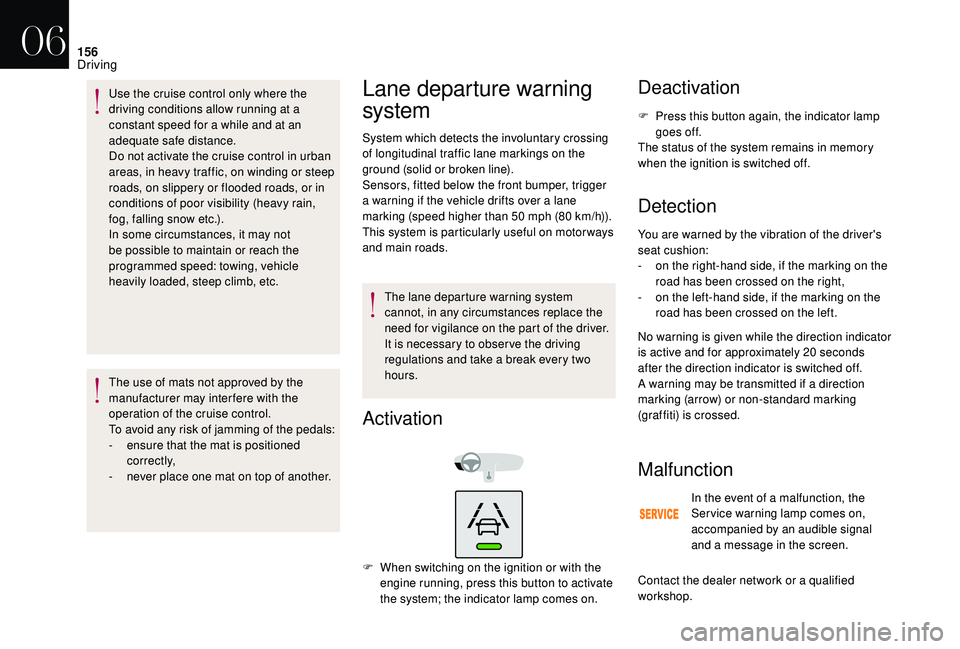
156
Use the cruise control only where the
driving conditions allow running at a
constant speed for a while and at an
adequate safe distance.
Do not activate the cruise control in urban
areas, in heavy traffic, on winding or steep
roads, on slippery or flooded roads, or in
conditions of poor visibility (heavy rain,
fog, falling snow etc.).
In some circumstances, it may not
be possible to maintain or reach the
programmed speed: towing, vehicle
heavily loaded, steep climb, etc.
The use of mats not approved by the
manufacturer may interfere with the
operation of the cruise control.
To avoid any risk of jamming of the pedals:
-
e
nsure that the mat is positioned
c o r r e c t l y,
-
n
ever place one mat on top of another.Lane departure warning
system
System which detects the involuntary crossing
of longitudinal traffic lane markings on the
ground (solid or broken line).
Sensors, fitted below the front bumper, trigger
a warning if the vehicle drifts over a lane
marking (speed higher than 50 mph (80 km/h)).
This system is particularly useful on motor ways
and main roads.The lane departure warning system
cannot, in any circumstances replace the
need for vigilance on the part of the driver.
It is necessary to obser ve the driving
regulations and take a break every two
hours.
Activation
F When switching on the ignition or with the engine running, press this button to activate
the system; the indicator lamp comes on.
Deactivation
F Press this button again, the indicator lamp goes off.
The status of the system remains in memory
when the ignition is switched off.
Detection
You are warned by the vibration of the driver's
seat cushion:
-
o
n the right-hand side, if the marking on the
road has been crossed on the right,
-
o
n the left-hand side, if the marking on the
road has been crossed on the left.
No warning is given while the direction indicator
is active and for approximately 20 seconds
after the direction indicator is switched off.
A warning may be transmitted if a direction
marking (arrow) or non-standard marking
(graffiti) is crossed.
Malfunction
In the event of a malfunction, the
Ser vice warning lamp comes on,
accompanied by an audible signal
and a message in the screen.
Contact the dealer network or a qualified
workshop.
06
Driving
Page 160 of 296
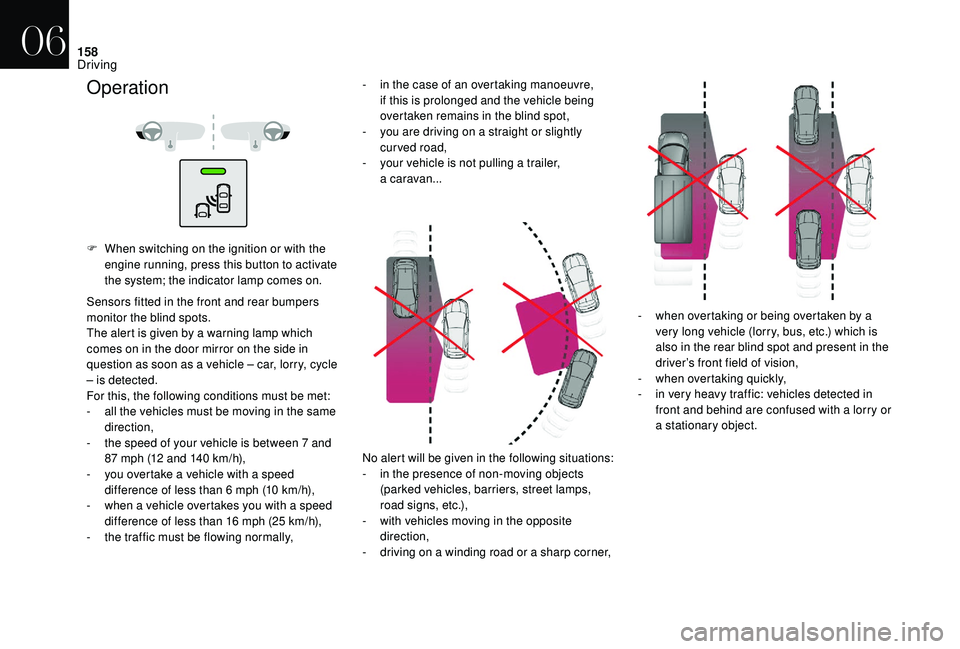
158
F When switching on the ignition or with the engine running, press this button to activate
the system; the indicator lamp comes on.
Sensors fitted in the front and rear bumpers
monitor the blind spots.
The alert is given by a warning lamp which
comes on in the door mirror on the side in
question as soon as a vehicle – car, lorry, cycle
– is detected.
For this, the following conditions must be met:
-
a
ll the vehicles must be moving in the same
direction,
-
t
he speed of your vehicle is between 7 and
87 mph (12 and 140 km/h),
-
y
ou overtake a vehicle with a speed
difference of less than 6 mph (10 km/h),
-
w
hen a vehicle overtakes you with a speed
difference of less than 16 mph (25 km/h),
-
t
he traffic must be flowing normally, No alert will be given in the following situations:
-
i
n the presence of non-moving objects
(parked vehicles, barriers, street lamps,
road signs, etc.),
-
w
ith vehicles moving in the opposite
direction,
-
d
riving on a winding road or a sharp corner,-
w
hen overtaking or being overtaken by a
very long vehicle (lorry, bus, etc.) which is
also in the rear blind spot and present in the
driver’s front field of vision,
-
w
hen overtaking quickly,
-
i
n very heavy traffic: vehicles detected in
front and behind are confused with a lorry or
a stationary object.
Operation- in the case of an overtaking manoeuvre, if this is prolonged and the vehicle being
overtaken remains in the blind spot,
-
y
ou are driving on a straight or slightly
curved road,
-
y
our vehicle is not pulling a trailer,
a
caravan...
06
Driving
Page 167 of 296
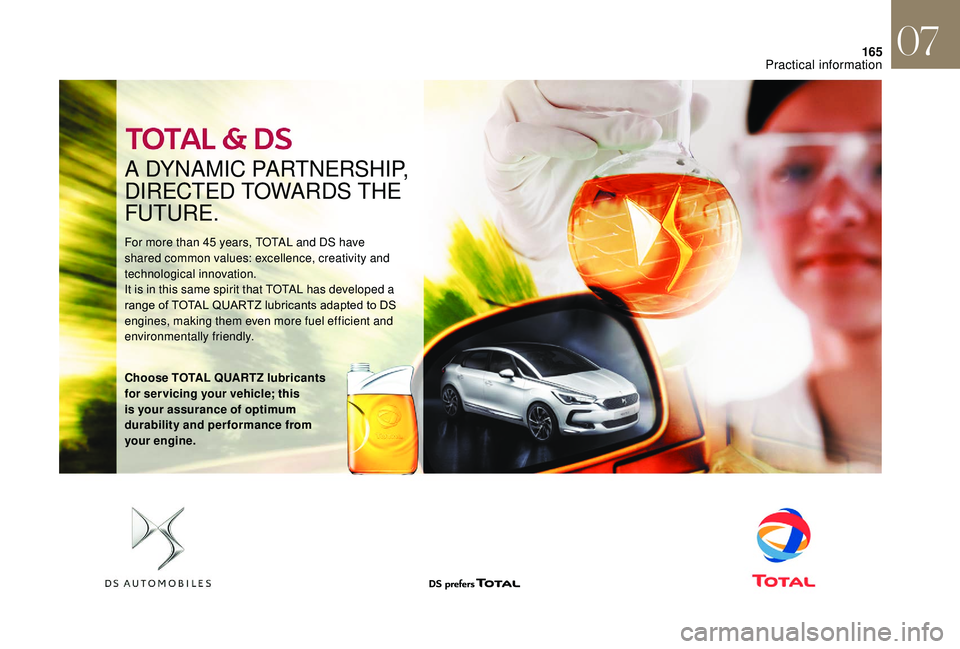
165
For more than 45 years, TOTAL and DS have
shared common values: excellence, creativity and
technological innovation.
It is in this same spirit that TOTAL has developed a
range of TOTAL QUARTZ lubricants adapted to DS
eng
ines, making them even more fuel efficient and
environmentally friendly.
Choose TOTAL QUARTZ lubricants
for ser vicing your vehicle; this
is your assurance of optimum
durability and per formance from
your engine.
A DYNAMIC PARTNERSHIP,
DIRECTED TOWARDS THE
FUTURE.
07
Practical information
Page 168 of 296
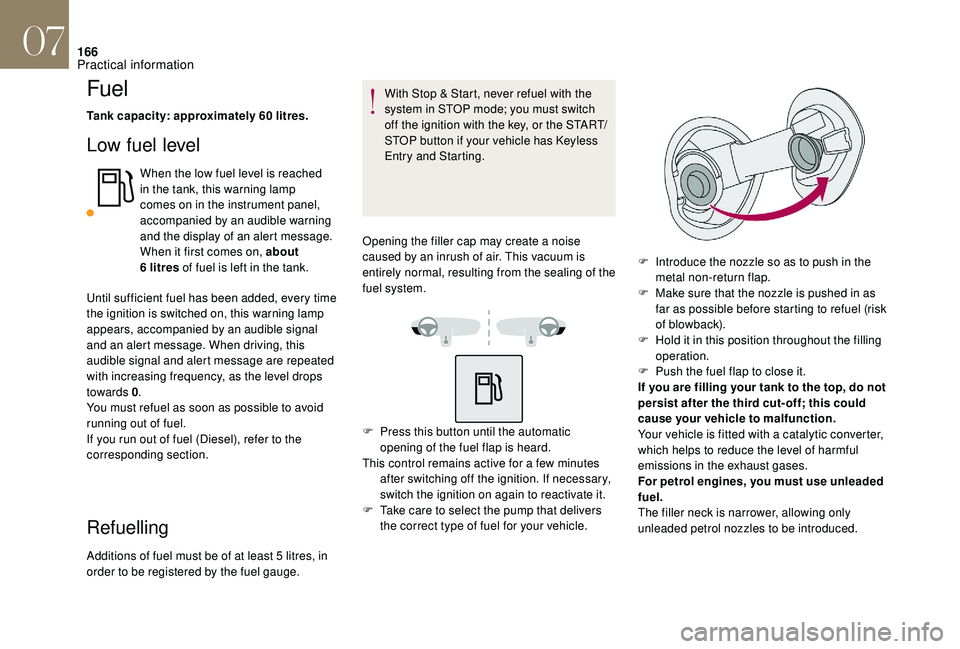
166
Fuel
Tank capacity: approximately 60 litres.
Low fuel level
When the low fuel level is reached
in the tank, this warning lamp
comes on in the instrument panel,
accompanied by an audible warning
and the display of an alert message.
When it first comes on, about
6 litres of fuel is left in the tank.
Until sufficient fuel has been added, every time
the ignition is switched on, this warning lamp
appears, accompanied by an audible signal
and an alert message. When driving, this
audible signal and alert message are repeated
with increasing frequency, as the level drops
towards 0 .
You must refuel as soon as possible to avoid
running out of fuel.
If you run out of fuel (Diesel), refer to the
corresponding section.
Refuelling
Additions of fuel must be of at least 5 litres, in
order to be registered by the fuel gauge. With Stop & Start, never refuel with the
system in STOP mode; you must switch
off the ignition with the key, or the START/
STOP button if your vehicle has Keyless
Entry and Starting.
Opening the filler cap may create a noise
caused by an inrush of air. This vacuum is
entirely normal, resulting from the sealing of the
fuel system.
F
P
ress this button until the automatic
opening of the fuel flap is heard.
This control remains active for a few minutes after switching off the ignition. If necessary,
switch the ignition on again to reactivate it.
F
T
ake care to select the pump that delivers
the correct type of fuel for your vehicle. F
I
ntroduce the nozzle so as to push in the
metal non-return flap.
F
M
ake sure that the nozzle is pushed in as
far as possible before starting to refuel (risk
of blowback).
F
H
old it in this position throughout the filling
operation.
F
P
ush the fuel flap to close it.
If you are filling your tank to the top, do not
persist after the third cut- off; this could
cause your vehicle to malfunction.
Your vehicle is fitted with a catalytic converter,
which helps to reduce the level of harmful
emissions in the exhaust gases.
For petrol engines, you must use unleaded
fuel.
The filler neck is narrower, allowing only
unleaded petrol nozzles to be introduced.
07
Practical information
Page 169 of 296
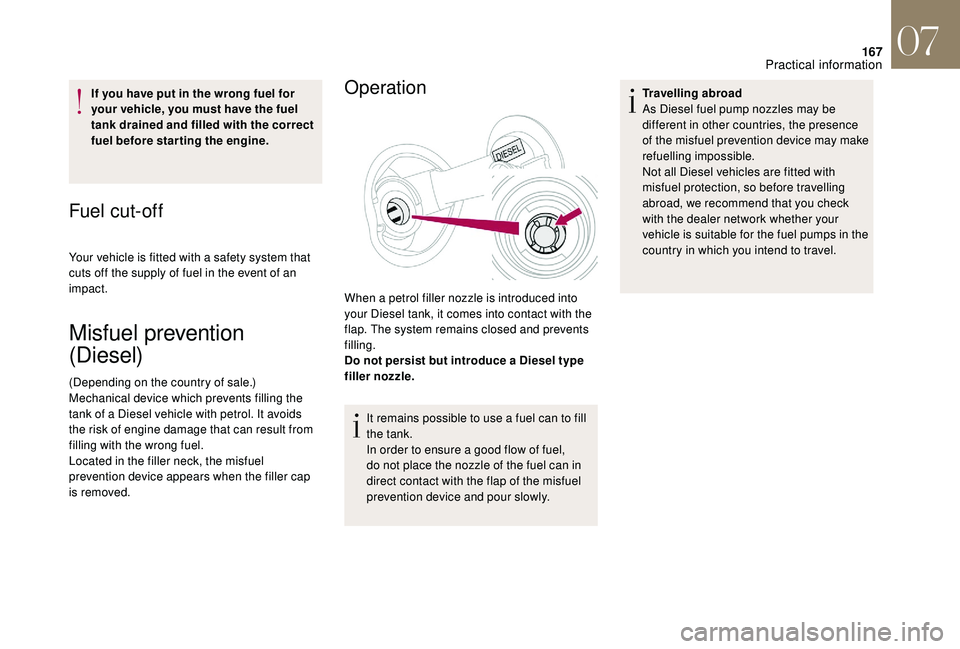
167
If you have put in the wrong fuel for
your vehicle, you must have the fuel
tank drained and filled with the correct
fuel before star ting the engine.
Fuel cut-off
Your vehicle is fitted with a safety system that
cuts off the supply of fuel in the event of an
impact.
Misfuel prevention
(Diesel)
(Depending on the country of sale.)
Mechanical device which prevents filling the
tank of a Diesel vehicle with petrol. It avoids
the risk of engine damage that can result from
filling with the wrong fuel.
Located in the filler neck, the misfuel
prevention device appears when the filler cap
is removed.
Operation
When a petrol filler nozzle is introduced into
your Diesel tank, it comes into contact with the
flap. The system remains closed and prevents
filling.
Do not persist but introduce a Diesel type
filler nozzle.It remains possible to use a fuel can to fill
the tank.
In order to ensure a good flow of fuel,
do not place the nozzle of the fuel can in
direct contact with the flap of the misfuel
prevention device and pour slowly. Travelling abroad
As Diesel fuel pump nozzles may be
different in other countries, the presence
of the misfuel prevention device may make
refuelling impossible.
Not all Diesel vehicles are fitted with
misfuel protection, so before travelling
abroad, we recommend that you check
with the dealer network whether your
vehicle is suitable for the fuel pumps in the
country in which you intend to travel.
07
Practical information
Page 170 of 296
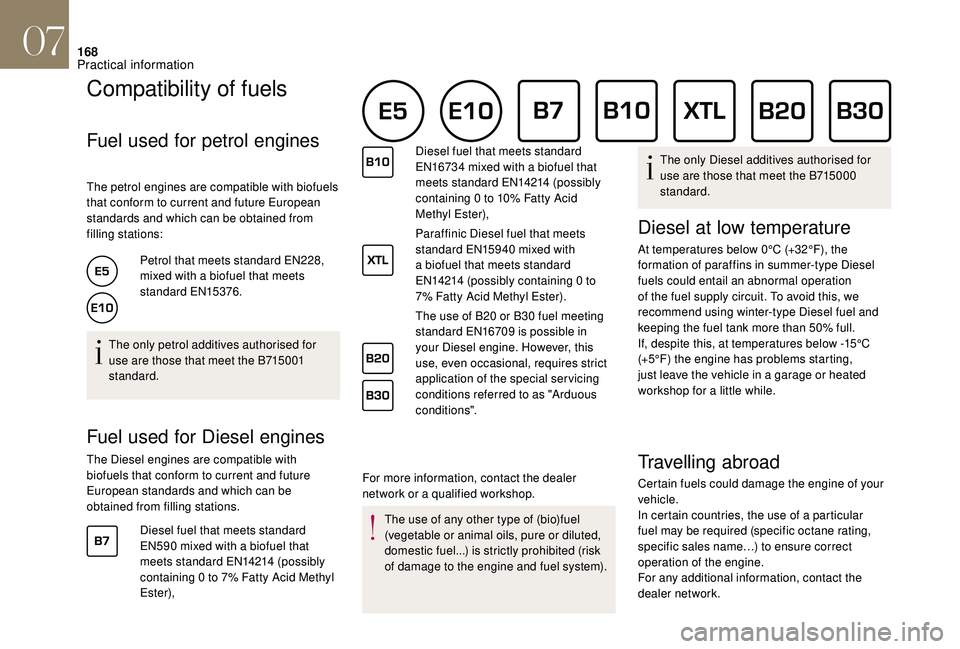
168
Compatibility of fuels
Fuel used for petrol engines
The petrol engines are compatible with biofuels
that conform to current and future European
standards and which can be obtained from
filling stations:Petrol that meets standard EN228,
mixed with a biofuel that meets
standard EN15376.
The only petrol additives authorised for
use are those that meet the B715001
standard.
Fuel used for Diesel engines
The Diesel engines are compatible with
biofuels that conform to current and future
European standards and which can be
obtained from filling stations. Diesel fuel that meets standard
EN590 mixed with a biofuel that
meets standard EN14214 (possibly
containing 0 to 7% Fatty Acid Methyl
Ester), For more information, contact the dealer
network or a qualified workshop.Diesel fuel that meets standard
EN16734 mixed with a biofuel that
meets standard EN14214 (possibly
containing 0 to 10% Fatty Acid
Methyl Ester),
Paraffinic Diesel fuel that meets
standard EN15940 mixed with
a biofuel that meets standard
EN14214 (possibly containing 0 to
7% Fatty Acid Methyl Ester).
The use of B20 or B30 fuel meeting
standard EN16709 is possible in
your Diesel engine. However, this
use, even occasional, requires strict
application of the special ser vicing
conditions referred to as "Arduous
conditions".
The use of any other type of (bio)fuel
(vegetable or animal oils, pure or diluted,
domestic fuel...) is strictly prohibited (risk
of damage to the engine and fuel system). The only Diesel additives authorised for
use are those that meet the B715000
standard.
Diesel at low temperature
At temperatures below 0°C (+32°F), the
formation of paraffins in summer-type Diesel
fuels could entail an abnormal operation
of the fuel supply circuit. To avoid this, we
recommend using winter-type Diesel fuel and
keeping the fuel tank more than 50% full.
If, despite this, at temperatures below -15°C
(+5°F) the engine has problems starting,
just leave the vehicle in a garage or heated
workshop for a little while.
Travelling abroad
Certain fuels could damage the engine of your
vehicle.
In certain countries, the use of a particular
fuel may be required (specific octane rating,
specific sales name…) to ensure correct
operation of the engine.
For any additional information, contact the
dealer network.
07
Practical information